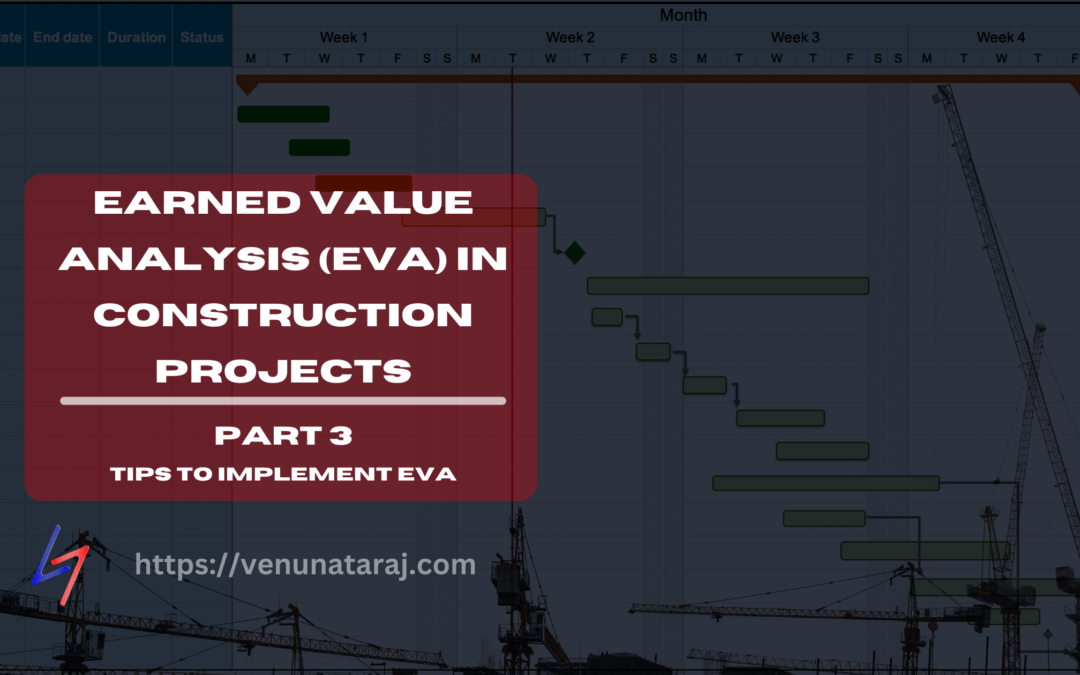Mastering Earned Value Analysis in Construction Projects: EVA Part 3
Introduction:
Welcome to Part 3 of our comprehensive guide on “Mastering Earned Value Analysis (EVA) in Construction Projects.” In the previous parts of this series, we laid the groundwork by exploring the fundamental concepts, key components, and practical application of EVA in construction.
Part 1 introduced us to the essential components and benefits of EVA, emphasizing its critical role in project control, cost management, and schedule adherence. Part 2 took us into the practical world of EVA, where we learned how this powerful technique is applied to measure progress, manage complex construction projects, and optimize resource utilization.
If you want to refer to the previous parts of this series, you can read them here:
Part 1: Mastering Earned Value Analysis in Construction Projects
Part 2: Mastering Earned Value Analysis in Construction Projects: Part 2
Now, in Part 3, we delve deeper into the practical aspects of implementing EVA effectively. We’ll share practical tips for leveraging EVA to enhance project control, cost management, and schedule adherence. From the importance of data accuracy to fostering open communication, these strategies will empower construction management professionals in their EVA journey.
Table of Contents
Practical Tips for Implementing EVA in Construction Projects
You’ve grasped the fundamentals of Earned Value Analysis (EVA) in construction projects. Now, let’s explore practical tips to effectively implement EVA and harness its power to enhance project control, cost management, and schedule adherence.
1. Data Accuracy Is Key
As mentioned earlier, EVA relies on accurate and up-to-date data. Ensure that your data collection processes are reliable and frequent. Invest in the necessary tools and systems to track project progress, costs, and schedules meticulously.
2. Start Early
Don’t wait until your project is well underway to implement EVA. Start at the planning stage. Define your project’s scope, create a detailed project plan, and establish your baseline. The sooner you start, the more data you’ll have to work with, allowing you to detect potential issues early.
3. Regularly Update Your EVA Metrics
EVA is not a “set it and forget it” tool. Continuously update your metrics as the project progresses. Regular updates ensure that you have the most accurate and current information, enabling you to make proactive decisions.
4. Set Clear Objectives and Targets
Before diving into EVA, define clear objectives and performance targets for your project. What are your cost and schedule goals? What level of variance is acceptable? Having these targets in place helps you assess whether you’re on the right track or need to make adjustments.
5. Monitor Trends
EVA allows you to not only measure your project’s performance at a specific point in time but also track trends. Are your performance indices improving, deteriorating, or stable? Monitoring trends can help you identify potential issues before they become critical.
6. Foster Communication
Effective communication is essential in construction projects. Share EVA data and insights with your project team. Collaborate to find solutions when issues arise. An open line of communication ensures that everyone is aligned with the project’s objectives.
7. Adapt to Change
Construction projects are dynamic, and changes are inevitable. Whether it’s scope changes, unforeseen issues, or resource constraints, be prepared to adapt your EVA metrics and plans accordingly. Flexibility is a key attribute of successful EVA implementation.
8. Training and Education
Invest in training and education for your project management team. Ensure they understand the principles, concepts, and formulas of EVA. Well-informed team members are more likely to apply EVA effectively in their day-to-day project management tasks.
9. Integrate EVA with Your Project Management Software
Leverage project management software that supports EVA calculations. Many modern tools offer EVA modules that simplify data input and automate calculations. Integration can streamline the process and reduce the risk of human error.
10. Seek Continuous Improvement
EVA is not a one-time exercise; it’s a journey of continuous improvement. Regularly review your EVA practices, assess what’s working and what’s not, and adjust your approach as needed. As you gain experience and insights, you can refine your EVA implementation for better results.
Closing Thoughts
Mastering Earned Value Analysis (EVA) in construction projects is a journey that requires dedication, attention to detail, and a commitment to improvement. It’s not just a tool; it’s a mindset that places project control, cost management, and schedule adherence at the forefront of your construction projects.
By implementing EVA effectively, you can steer your projects towards success. You’ll gain the ability to identify delays or cost overruns early and take proactive measures to manage your projects more efficiently. EVA empowers you to make data-driven decisions, ensuring that your projects are on time and within budget.
As you embark on your journey to master EVA, remember that it’s a continuous process. Stay dedicated, learn from your experiences, and adapt your practices to suit the unique challenges of each construction project. In doing so, you’ll set yourself apart as a construction management professional who takes project control seriously.

